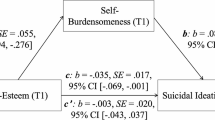Abstract
The Interpersonal-Psychological Theory of Suicidal Behavior proposes precursors to serious suicidality, including the perception that one is a burden on loved ones. The purpose of the present study was to evaluate the association of perceived burdensomeness and key suicide-related variables in 343 adult outpatients of the Florida State University Psychology Clinic (187 female; 156 male). Participants completed the Beck Scale for Suicide Ideation and the Beck Depression Inventory, as well as items on perceived burdensomeness and hopelessness. Perceived burdensomeness remained a significant predictor of suicidality indicators (i.e., attempt status and BSSI scores) above and beyond the contribution one of the most robust predictors of suicidality, hopelessness. Results suggest that both burdensomeness and hopelessness display predictive power with regards to suicidal behavior and that perceived burdensomeness displayed the signature of a resilient suicide risk factor. Thus, targeting perceived burdensomeness in the assessment of suicidal behavior may aid in treatment and prevention efforts.
Similar content being viewed by others
Notes
Two models which included a quadratic term for burdensomeness (i.e., burdensomeness-squared) were run to examine of the form of the relationship between burdensomeness and (1) current suicidal symptoms and (2) past suicide attempts. In the final step of both models, burdensomeness and burdensomeness-squared remained significant predictors of current suicidality, suggesting the potential for a curvilinear relationship. However, the burdensomeness main effect (our effect of interest) remained significant in both models after the inclusion of burdensomeness-squared. Future studies could further clarify the form of the relationship between perceived burdensomeness and suicidal symptoms.
Two additional models were run to examine the relationship between perceived burdensomeness, hopelessness, and suicidality. The first model included the interaction of perceived burdensomeness and hopelessness in the final step in the prediction of current suicidal symptoms; this interaction was significant, suggesting the need for additional studies to examine the interactive effects of perceived burdensomeness and hopelessness in the prediction of current suicidal symptoms. The second model included the interaction of perceived burdensomeness and hopelessness in the final step in the prediction of past attempts; this interaction was not significant. Additional studies are needed to replicate this effect as well as investigate potential explanations for the lack of interaction between perceived burdensomeness and hopelessness for past suicide attempts and the presence of an interaction for current suicidal symptoms.
References
Beck, A. T., & Steer, R. A. (1991). Manual for Beck scale for suicide ideation. San Antonio, TX: Psychological Corporation.
Beck, A. T., Rush, A. J., Shaw, B. F., & Emery, G. (1979). Cognitive therapy of depression: A treatment manual. New York: Guilford Press.
Berlim, M. T., Mattevi, B. S., Pavanello, D. P., Caldieraro, M. A., Fleck, M. P. A., Wingate, L. R., & Joiner, T. (2003). Psychache and suicidality in adult mood disordered outpatients in Brazil. Suicide & Life-Threatening Behavior, 33, 242–248.
Brown, G., Beck, A. T., Steer, R., & Grisham, J. (2000). Risk factors for suicide psychiatric outpatients: A 20-year prospective study. Journal of Consulting & Clinical Psychology, 68, 371–377.
Brown, R. M., Dahlen, E., Mills, C., Rick, J., & Biblarz, A. (1999). Evaluation of an evolutionary model of self-preservation and self-destruction. Suicide & Life-Threatening Behavior, 29, 58–71.
Cohen, J. (1988). Statistical power analysis for the behavioral sciences. Hillsdale, NJ: Lawrence Erlbaum Associates.
DeCatanzaro, D. (1995). Reproductive status, family interactions, and suicidal ideation: Surveys of the general public and high-risk groups. Ethology & Sociobiology, 16, 385–394.
Fennig, S, Craig, T. J., Tanenburg-Karant, M., & Bromet, E. J. (1994). Comparison of facility and research diagnoses in first-admission psychotic patients. American Journal of Psychiatry, 151, 1423–1429.
First, M. B., Spitzer, R. L., Gibbon, M., & Williams, J. B. (1995). The Structured Clinical Interview for DSM-III-R personality disorders (SCID-II): I. Description. Journal of Personality Disorders, 9, 83–91.
Joiner, T. E. (2005). Why People Die By Suicide. Cambridge, MA: Harvard University Press.
Joiner, T., Gencoz, F., Gencoz, T., Metalsky, G., & Rudd, M. D. (2001). Does self-hatred imbue schizophrenia with a suicidal quality? Journal of Psychopathology & Behavioral Assessment, 23, 107–116.
Joiner, T. J., Katz, J., & Lew, A. S. (1997). Self-verification and depression among youth psychiatric inpatients. Journal of Abnormal Psychology, 106, 608–618.
Joiner, T. J., & Lonigan, C. J. (2000). Tripartite model of depression and anxiety in youth psychiatric inpatients: Relations with diagnostic status and future symptoms. Journal of Clinical Child Psychology, 29, 372–382.
Joiner, T., Pettit, J. W., Walker, R. L., Voelz, Z. R., Cruz, J., Rudd, M. D., & Lester, D. (2002). Perceived burdensomeness and suicidality: Two studies on the suicide notes of those attempting and those completing suicide. Journal of Social & Clinical Psychology, 21, 531–545.
Leighton, A. H., & Hughes, C. C. (1955). Notes on Eskimo patterns of suicide. Southwestern Journal of Anthropology, 11, 327–338.
Lonigan, C. J., Carey, M. P., & Finch, A. J. (1994). Anxiety and depression in children and adolescents: Negative affectivity and the utility of self-reports. Journal of Consulting & Clinical Psychology, 62, 1000–1008.
Maris, R., Berman, A., & Silverman, M. (2000). Comprehensive textbook of suicidology. New York: Guilford Press.
Rudd, M. D., Joiner, T., & Rajab, M. H. (2001). Treating suicidal behavior. New York: Guilford.
Rudd, M. D., Joiner, Jr., T. E., & Rajab, M. H. (1996). Relationships among suicide ideators, attempters, and multiple attempters in a young-adult sample. Journal of Abnormal Psychology, 105, 541–550.
Wingate, L. R., Van Orden, K. A., Joiner, Jr., T. E., Williams, F. M., & Rudd, D. M. (2005). Comparison of Compensation and Capitalization Models When Treating Suicidality in Young Adults. Journal of Consulting and Clinical Psychology, 73, 756–762.
Author information
Authors and Affiliations
Corresponding author
Rights and permissions
About this article
Cite this article
Van Orden, K.A., Lynam, M.E., Hollar, D. et al. Perceived Burdensomeness as an Indicator of Suicidal Symptoms. Cogn Ther Res 30, 457–467 (2006). https://doi.org/10.1007/s10608-006-9057-2
Published:
Issue Date:
DOI: https://doi.org/10.1007/s10608-006-9057-2




